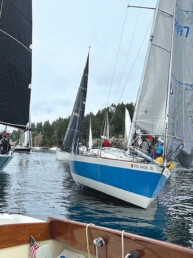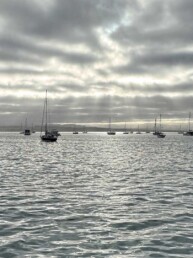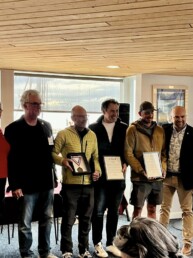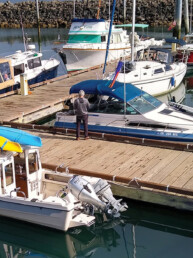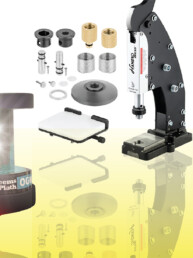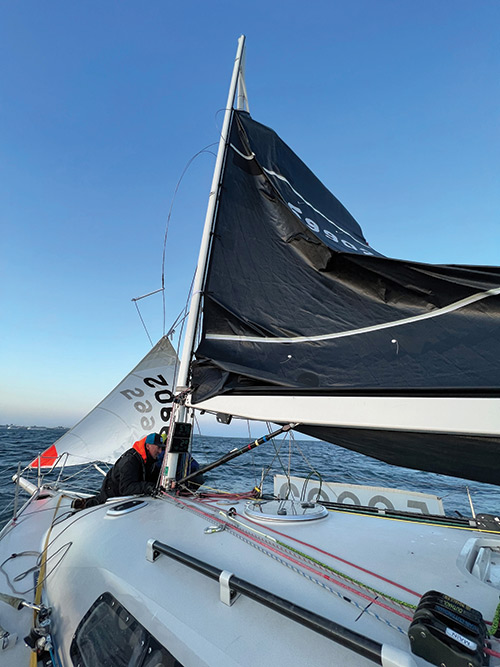
True Wind Speed: 32, 34, 36, 39… BANG. The rig folded in half between the first and second spreader and collapsed to leeward. What had been a roaring and raucous ride was suddenly eerily quiet. However, when you are lucky enough to sail with a team as determined as the one I was a part of on the Riptide 35 Terramoto for the 2023 Swiftsure race, it’s never over until it’s over.
While countless sailors have done many more Swiftsures than me, I have been lucky enough to finish six over the last eight years. Though Swiftsure can get a bad rap for strong currents, light air, and un-settled seastates, it remains the granddaddy of all Pacific Northwest distance races; and if you want a taste of open ocean sailing, the 40 mile stretch of water between Race Rocks and Neah Bay is an ideal place to test your boat and your crew.
The buzz around the dock on Friday was one of nervous energy. As ever, there was talk of weather models, a jumble of acronyms like ECMWF, HRRR, GFS, and NAM. For our team of six on Terramoto, we had a simple view of the weather prognosis for the race. If it was cold out on the ocean and warm towards the interior of Washington, it was only a matter of time before the westerly wind would start to pump in from the ocean. We had a talented crew of Seattle area sailors: Bill Weinstein the owner and skipper, Stasi Burzycki on the main, Herb Cole on the sheets, Tim Scanlon doing the pit and navigation, AnaLucia Clarkson on the bow, and myself as the floater and tactician.
The Saturday morning rush can be anxiety provoking, as boats try to un-raft and get out to the 9:00 a.m. start. However, we had a plan and we stuck to it — 6:50 meet in the lobby, 7:00 breakfast, 7:20 walk down to the boat, 7:45 lines off. We had a slow motor out to the start line going over our final checks, getting the main and jib up and checking batten tensions. We were all ready to go but there was an important ingredient missing…wind! There was no sign of the forecast 15-knot westerly, and instead we were left to grapple with a light southeasterly.
We were the second start so we had the benefit of watching the Hein Bank and Swiftsure Classic boats navigate the minefield of wind holes and current rips that lay between the start and Race Passage. The lead TP52, Glory, had a good start down at the Clover Point end and was leading the fast class. However, we chose to start farther up toward the middle of the line in order to keep our options a little more open. Annapurna and Manifest were both looking strong down on that Clover Point end when the gun went off for our Cape Flattery Race start. While we all had spinnakers up, we could see the advancing westerly and knew it was only a matter of time before jibs would be going up and we would be getting into the grind of a 50-mile beat out to Neah Bay. We managed the transition fairly well and sat just behind Annapurna who was leading our class. However, as the wind built we managed to shift gears well and lead our class at Race Passage.
What followed was a test of judgment and seamanship as all the boats had to manage a jib change due to the heavy weather. However, if you did it too early, you would be underpowered and wallow in the current-induced short chop. Do it too late and you would run the risk of damaging sails and wearing out your crew. On Terramoto, we kept our sail selection simple and changed directly from the J2 to the much smaller, J4. This is no simple task on Terramoto, as you have to hank on the J4 on an inner headstay and then douse and remove the hanks from the J2 on the outer headstay. However, we had a drama-free change and with the J2 safely in the bag and down below, we began the long starboard tack slog across the strait.
As the fleet made its way over to the Washington shore, a three boat drag-race developed between us, the J/125 Hamachi, and the Farr 39CR Tachyon began. The wind reached as high as 28-30 knots but we managed to hold our own with the longer and heavier boats. Both Hamachi and Tachyon found their way around us by Neah Bay, but we were thrilled to round the mark in third on the water.
By this point, the wind had abated to 18-22 knots so we set the heavy A2 spinnaker and began our sail back to Race Rocks, taking a few digs towards the Washington shore before the long port jibe drag race toward Sheringham. The wind continued to build until the true wind speed rarely dropped below 25. Top boatspeeds were now in the low 20s, but Terramoto was still under a reasonable amount of control. With the breeze pumping and the waves short and steep, we were wishing for a smaller spinnaker to reduce the stress on the boat and crew. Like most boats optimized for Pacific Northwest racing, though, our heavy air spinnaker inventory was sparse. As a consequence, we had to carry on with the big kite and just try to keep the wheels on the bus.
As we approached Race Rocks, we opted to play it safe and douse the kite about a mile west of the lighthouse before heading up and jib-reaching through Race Passage. With the seas flattening out and sharp jagged rocks to leeward moving farther behind us, we all took a big sigh of relief. Maybe that relief was a sign of our own hubris as we set the kite again in what seemed like diminishing breeze in the lee of Vancouver Island. Suddenly, not 1 minute after our set, the wind was over 30 knots again and building.
That brings us to where we began, 8 miles from the finish with a broken mast and a sense of uncertainty of what to do next. Herb and Bill quickly reminded everyone that finishing was still an option, even with our compromised sail plan. After cleaning up what we could of the carnage, Herb sprang to action and began to rig up the storm trysail as a sort of jury-rig jib between the bow and what was left of the mast. Excellent, an extra knot of speed! So it was that we limped back to Victoria and crossed the line just after sunset, first over the line for our fleet.
Our challenges were not over, however, we still had to find a way to pull the main down so that we could undergo our final race obligation: the safety inspection. We elected to take down the main well inside the harbor where the wind was lighter. After some deliberation and a small amount of squabbling, we managed to free what was left of the main from the mast and get it back down to deck level — thanks in large part to Ana’s clever problem solving and Herb’s willingness to pull harder than anyone else. We made it to the dock just after 10:30 p.m. and had our lines graciously caught by the crew of the J/35 Tahlequah.

For our team, it was a bittersweet finish. We were pleased with the result and the race we had sailed; and were honored to have set a new Cape Flattery Race course record, beating 1D48 Flash’s previous record by 43 minutes. I was particularly proud of the way the team managed the challenges of the race, especially the final hour after the mast broke. It was a performance to be proud of and a reminder that discretion can be the better part of valor.
The Swiftsure Race remains an important test for any racer in the PNW. It can offer a taste of tough ocean conditions, light and heavy, and aid a crew in discovering not only the limits of their boat, but also themselves. Every single one of the Swiftsures I have done has taught me something important, this year was no different. Next year when we return to Victoria, I know we will all learn something yet again.

